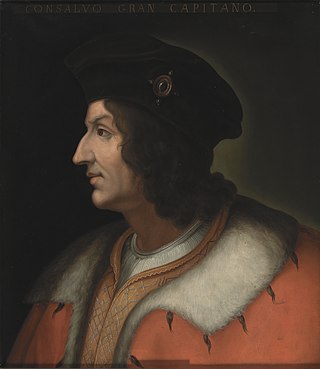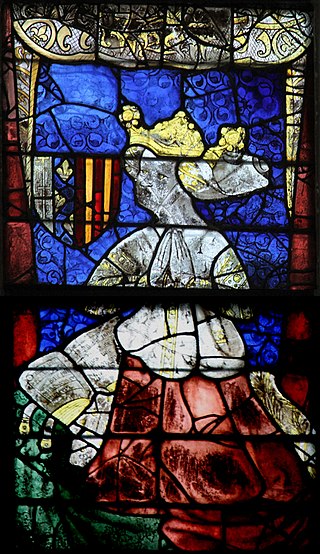
Louis XII was King of France from 1498 to 1515 and King of Naples from 1501 to 1504. The son of Charles, Duke of Orléans, and Marie of Cleves, he succeeded his second cousin once removed and brother-in-law, Charles VIII, who died childless in 1498.

Roger II or Roger the Great was King of Sicily and Africa, son of Roger I of Sicily and successor to his brother Simon. He began his rule as Count of Sicily in 1105, became Duke of Apulia and Calabria in 1127, then King of Sicily in 1130 and King of Africa in 1148.

René of Anjou was Duke of Anjou and Count of Provence from 1434 to 1480, who also reigned as King of Naples as René I from 1435 to 1442. Having spent his last years in Aix-en-Provence, he is known in France as the Good King René.

Charles III was King of Spain in the years 1759 to 1788. He was also Duke of Parma and Piacenza, as Charles I (1731–1735); King of Naples, as Charles VII; and King of Sicily, as Charles III (1735–1759). He was the fourth son of Philip V of Spain and the eldest son of Philip's second wife, Elisabeth Farnese. He was a proponent of enlightened absolutism and regalism.

Ferdinand I, also known as Ferrante, was king of Naples from 1458 to 1494.
Charles of Durazzo, also called Charles the Small, was King of Naples and the titular King of Jerusalem from 1382 to 1386 as Charles III, and King of Hungary from 1385 to 1386 as Charles II. In 1381, Charles created the chivalric Order of the Ship. In 1383, he succeeded to the Principality of Achaea on the death of James of Baux.

The Kingdom of Naples, also known as the Kingdom of Sicily, was a state that ruled the part of the Italian Peninsula south of the Papal States between 1282 and 1816. It was established by the War of the Sicilian Vespers (1282–1302), when the island of Sicily revolted and was conquered by the Crown of Aragon, becoming a separate kingdom also called the Kingdom of Sicily. This left the Neapolitan mainland under the possession of Charles of Anjou. Later, two competing lines of the Angevin family competed for the Kingdom of Naples in the late 14th century, which resulted in the death of Joanna I by Charles III of Naples. Charles' daughter Joanna II adopted King Alfonso V of Aragon as heir, who would then unite Naples into his Aragonese dominions in 1442.

King of Italy was the title given to the ruler of the Kingdom of Italy after the fall of the Western Roman Empire. The first to take the title was Odoacer, a barbarian warlord, in the late 5th century, followed by the Ostrogothic kings up to the mid-6th century. With the Frankish conquest of Italy in the 8th century, the Carolingians assumed the title, which was maintained by subsequent Holy Roman Emperors throughout the Middle Ages. The last Emperor to claim the title was Charles V in the 16th century. During this period, the holders of the title were crowned with the Iron Crown of Lombardy.

Gonzalo Fernández de Córdoba was a Spanish general and statesman who led successful military campaigns during the Conquest of Granada and the Italian Wars. His military victories and widespread popularity earned him the nickname “El Gran Capitán”. He also negotiated the final surrender of Granada and later served as Viceroy of Naples. Fernández de Córdoba was a masterful military strategist and tactician.

Yolande of Aragon was Duchess of Anjou and Countess of Provence by marriage, who acted as regent of Provence during the minority of her son. Yolande played a crucial role in the struggles between France and England, influencing events such as the financing of Joan of Arc's army in 1429 that helped tip the balance in favour of the French. She was also known as Yolanda de Aragón and Violant d'Aragó. Tradition holds that she commissioned the famous Rohan Hours.

Frederick, sometimes called Frederick IV or Frederick of Aragon, was the last king of Naples from the Neapolitan branch of the House of Trastámara, ruling from 1496 to 1501. He was the second son of Ferdinand I, younger brother of Alfonso II, and uncle of Ferdinand II, his predecessor.

The First Italian War, or Charles VIII's Italian War, was the opening phase of the Italian Wars. The war pitted Charles VIII of France, who had initial Milanese aid, against the Holy Roman Empire, Spain and an alliance of Italian powers led by Pope Alexander VI, known as the League of Venice.
The Neapolitan Republic was a republic created in the Kingdom of Naples, which lasted from October 22, 1647, to April 5, 1648. It began after the successful revolt led by Masaniello and Giulio Genoino against King Philip III and his viceroys.

Infanta Maria Luisa of Spain was Holy Roman Empress, German Queen, Queen of Hungary and Bohemia, and Grand Duchess of Tuscany as the spouse of Leopold II, Holy Roman Emperor.

The State of the Presidi was a small territory on the Tuscan coast of Italy that existed between 1557 and 1801. It consisted of remnants of the former Republic of Siena—the five towns of Porto Ercole and Porto Santo Stefano on the promontory of Monte Argentario, as well as Orbetello, Talamone and Ansedonia—and their hinterland, along with the islet of Giannutri and the fortress of Porto Longone on the island of Elba.

The Capetian House of Anjou, or House of Anjou-Sicily, or House of Anjou-Naples was a royal house and cadet branch of the Capetian dynasty. It is one of three separate royal houses referred to as Angevin, meaning "from Anjou" in France. Founded by Charles I of Anjou, the youngest son of Louis VIII of France, the Capetian king first ruled the Kingdom of Sicily during the 13th century. The War of the Sicilian Vespers later forced him out of the island of Sicily, which left him with the southern half of the Italian Peninsula, the Kingdom of Naples. The house and its various branches would go on to influence much of the history of Southern and Central Europe during the Middle Ages until it became extinct in 1435.

Louise Marie Thérèse d'Artois was a duchess and later a regent of Parma. She was the eldest daughter of Charles Ferdinand, Duke of Berry, younger son of King Charles X of France and Princess Caroline of Naples and Sicily. She served as regent of Parma during the minority of her son from 1854 until 1859.

Princess Marie of Orléans was a French princess, artist, and, by her marriage, duchess of Württemberg (1837). Before her marriage she was styled Mademoiselle de Valois.
Francis of Baux was the first Duke of Andria, Count of Montescaglioso and Squillace, and Lord of Berre, Mison, and Tiano. He was the son of Bertrand III of Baux, Count of Andria and Montescaglioso and his second wife, Marguerite d'Aulnay. Francis's father was a Senator of Rome, Captain General of Tuscany, and Justiciar of Naples. The half-royal Baux family was one of the greatest families of the kingdom after the Duke's marriage to Marguerite of Taranto in 1348.